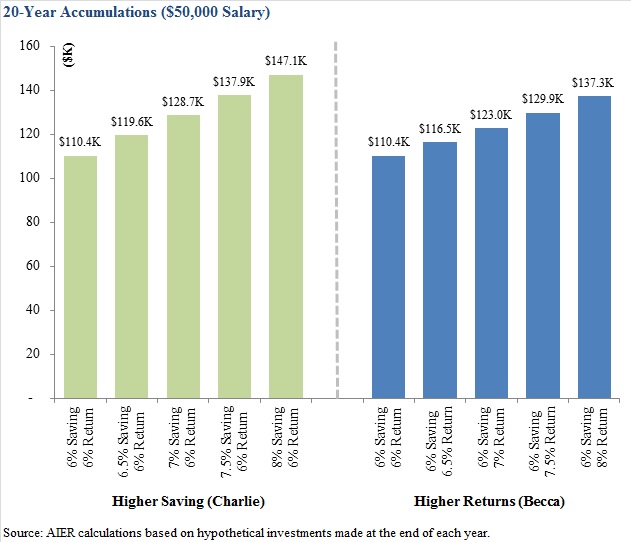A Guaranteed Way to Get Higher 401(k) Balances
Investors and professional financial advisors often focus on tweaking asset allocations in order to max out returns and reduce volatility. Professional money managers receive huge bonuses if they can outperform the market by even a modest amount. Following one set of guidelines or another may increase your returns, but there is no guarantee and no free lunch.
The good news is that there is a simple way to guarantee that you have more money saved in the future: You can increase your saving. Saving a little more every month is a more effective way of making sure you’ll have enough saved in the future, as opposed to fretting over whether to allocate 16 percent or 18 percent to international equities this year in hopes of generating excess return.
Take the simple examples of Al, Becca, and Charlie, all of whom are 45 years old, and are hoping to retire at age 65:
Al saves 6 percent of his $50,000 salary every year for 20 years. He is comfortable investing 60 percent in stocks, and so he allocates to a simple 60/40 portfolio and automatically rebalances annually. Let’s assume he gets an annual return of 6.0 percent. His balance after 20 years will be $110,357.
Becca saves the same 6 percent of her $50,000 salary every year for 20 years, but she works diligently to tweak her allocations every year. She follows the economic news, reads The Wall Street Journal, and spends hours every week thinking about how to improve the performance of her portfolio. She is able to generate a full 0.5 percent extra per year. (This may be extremely difficult in reality). Her return is 6.5 percent per year, leaving her with $116,476 at the end of 20 years, $6,119 more than Al.
Charlie, similar to Al, does not care to spend his spare time reading the financial press and agonizing over his annual allocations. He decides to increase his savings by an extra $20 per month, for a total savings of 6.48 percent of his $50,000 pre-tax salary. He receives only the 6 percent return that Al receives, but he finishes his 20 years with $119,185 in his account, $8,829 more than Al and $2,709 more than Becca.
Now, compound interest will eventually take over. If Becca continues her hot streak until she’s 75 years old, she will have about $3,000 more than Charlie. However, that assumes she can outperform by a half percent every year for 30 years… No small task. This also assumes that they having nothing saved yet; for those with large current balances, an extra 0.5 percent return could mean huge amounts in the future. But Al, Becca, and Charlie are average Americans that don’t have huge account balances by the time they’re 45.
The point is that there are diminishing returns to financial knowledge for typical investors. It’s critical that Al and Charlie had the knowledge to invest in low-fee funds, to rebalance their portfolios, and to endure market turbulence without making impulsive trades. But beyond that, they needed little financial knowledge to get reasonable rates of return.
Becca presumably has extensive financial knowledge, and it paid off. The sacrifice is many hours of study and the potential agony of paying close attention to market turbulence, while Charlie blissfully fishes down at the pond.












